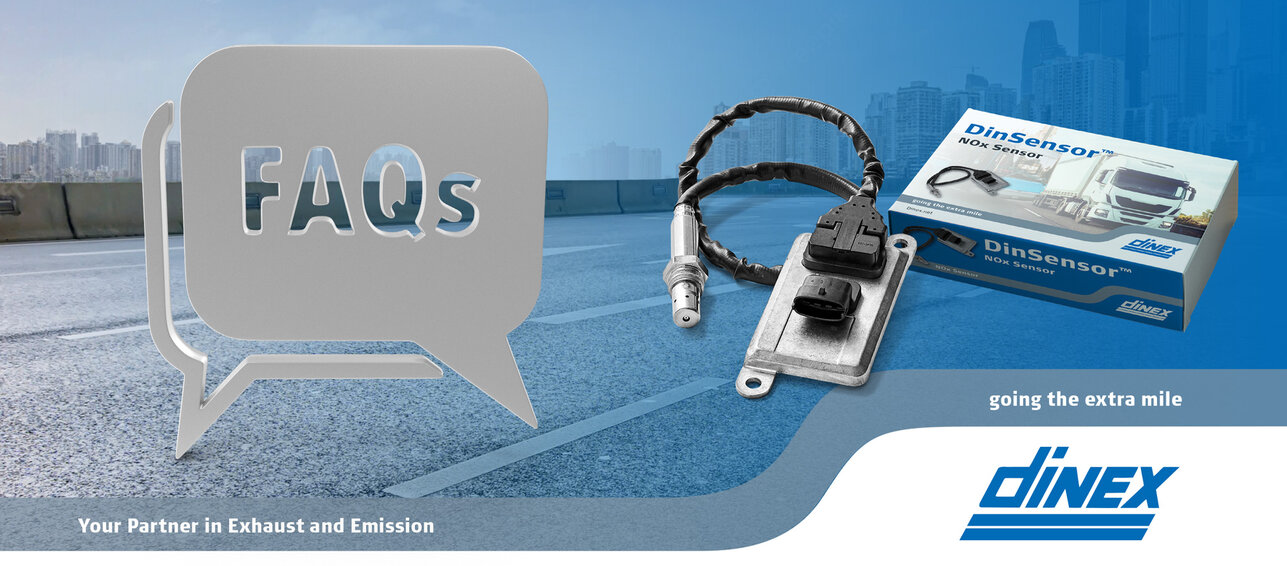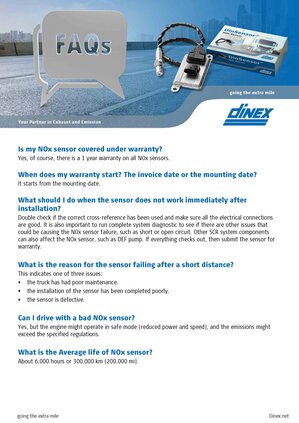- Mechatronics
- NOx Sensor
- FAQ

Frequently asked questions - Dinex NOx sensors
Is my NOx sensor covered under warranty?
Yes, of course, there is a 1 year warranty on all NOx sensors.
When does my warranty start? The invoice date or the mounting date?
It starts from the mounting date.
What should I do when the sensor does not work immediately after installation?
Double check if the correct cross-reference has been used and make sure all the electrical connections are good. It is also important to run complete system diagnostic to see if there are other issues that could be causing the NOx sensor failure, such as short or open circuit. Other SCR system components can also affect the NOx sensor, such as DEF pump. If everything checks out, then submit the sensor for warranty.
What is the reason for the sensor failing after a short distance?
This indicates one of three issues:
- the truck has had poor maintenance.
- the installation of the sensor has been completed poorly.
- the sensor is defective.
Can I drive with a bad NOx sensor?
Yes, but the engine might operate in safe mode (reduced power and speed), and the emissions might exceed the specified regulations.
What is the Average life of NOx sensor?
About 6,000 hours or 300,000 km (200,000 mi).
Can we clean the NOx sensor head?
You can clean on your own risk, if cleaning fails, the sensor will not be accepted under warranty.
Can I use an outlet NOx sensor in the place of inlet sensor and vice-versa?
This is not recommended. Both sensors operate at different NOx concentration levels, and they might communicate differently.
What is the difference between OEM and Dinex sensor?
The same technology and construction is used in both OE and Dinex sensors. They are essentially analogous to each other. The only difference is that OE manufacturers get to decide what software will be used while Dinex is attempting to replicate it.
My NOx sensor reports an error at 0 km, how can that be?
That happens because of a failure in communication protocol. Possible reasons: incorrect cross-reference, recently updated truck’s software, or broken sensor circuit.
Does the sensor have the same calibration as OE (ppm levels)?
Yes, although generally AEM sensor tend to have a bit wider tolerance zone compared to OE sensors.
How can I determine if the sensor comes installed with the correct software?
The only way is to compare Continental cross-references.
What do I need to check at installation?
Currently, we advise installing the sensor according to truck manufacturer’s instructions, as they are different in each case. In general, it is essential to check if all the electrical connections are clean and free of debris and that the sensor has not been damaged during installation. The cable should be tension-free, and the interface box should not touch the silencer or subframe with any other part than the mounting brackets.
Are the Dinex sensors Continental?
No, they are not produced by Continental.
If they are not Continental, why do they rely so heavily on the Continental part numbers for cross referencing and applications?
Because our sensors are meant to replace the Continental product.
Do the Dinex sensors have an NGK sensor head?
No, Dinex sensors have their own, unique sensor heads.
Why does the OE equivalent work but Dinex (and other AM equivalents) don’t work in some instances?
The most common reason for this is incompatible communication protocols (software). Either cross-referencing is wrong, or the truck has recently been updated.
Do they need programming?
No.
Do they have a ‘bedding in’ period for the ECU to recognise the new sensor, and if so, what is it or how long should I wait?
This process is described in truck manufacturer’s instructions for NOx sensor replacement. In general, this process can take up to 15 minutes from ignition ON (engine start).
Why are the Dinex sensors more expensive than some other AM equivalents?
Because Dinex adds value with every sensor it sells, by helping our customers before, during, and after the purchase.
Why should I switch to Dinex sensors?
The price point should be very attractive compared to OE, coupled with support from both sales and quality departments.
Do they need to be changed in pairs?
This is not mandatory, but very much recommended to decrease the likelihood of failure.
I have some old Dinex stock, are they no longer up to date if the OE has made changes?
If the result of these changes is that the sensors no longer work, then yes. The newest generation product will be compatible with re-flashing, which means we can update the stock to the newest version.
If we have an issue with the sensor at the time of fitting, where do we go for technical assistance?
The first point of technical assistance should be the manufacturer’s troubleshooting guide. We also have dedicated support teams that support your local Dinex site.
Why are our NOx sensors so problematic?
There are several reasons for this: incorrect cross referencing, poor truck maintenance, poor installation, software updates, and finally, product quality. All these factors are interconnected and are often blamed on the NOx sensor, which is responsible for only a fraction of the problems.
Which sensor (reference) goes in front of the silencer and which one goes in the rear? How do I recognize it?
According to our catalogue, vehicle compatibility check file, or based on the number of pins in the connector. Post-SCR sensors have one extra pin for additional grounding.
Is there a list that can be used to tell which engine the NOx sensor is for (e.g., DAF XF 450 or 550)?
This information is displayed in our catalogue, but Continental cross referencing is the recommended way.
What is the difference between Dinex NOx sensors and sensors made by other producers?
Dinex adds value to the sensor by establishing continuous improvements to the product range to solve problems and guide our customers to make the correct choice.
Is NOx Sensor the same as the Oxygen Sensor?
The principle of operation is similar, but NOx sensor is more advanced. It also measures the oxygen levels as a side-effect.
Is it easier to turn off the NOx sensor system than change the sensor every time?
It is easier but not recommended, as it would disable the whole aftertreatment system.
Soot on NOx sensor – OK or not OK?
Depends on the location of sensor. The soot should be dark grey and dry. If it is completely black and oily, the DPF system needs servicing and will cause NOx sensor failure.
Do Dinex Quality Specialists test each sensor before sending it to customers?
Unfortunately, no. This would dramatically increase the price-point. The sensors are mass-tested industrially after the manufacturing process.
What is our warranty failure rate?
Our rate is equivalent to OE sensor failure rate and we embark on a process of continuous improvement to provide value to our customers.
